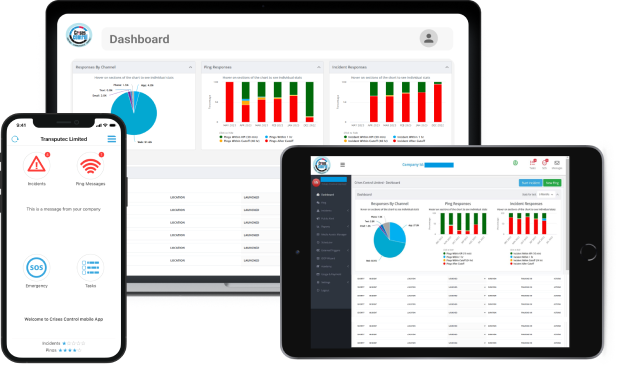Written by Anneri Fourie | Crises Control Executive
When disaster strikes, the ability to respond quickly can be the difference between a manageable disruption and a full-blown crisis.
Many organisations have a business continuity plan (BCP) outlining how they’ll respond to challenges. But having a plan in place is only the first step; without clear, timely instructions reaching employees and stakeholders, even the best strategy can fall short.
That’s where emergency alert software comes into play. By integrating real-time notifications into your business continuity framework, you ensure that your team, customers, and partners are always informed and can take swift, coordinated action when it matters most.
In this blog, we’ll explore why emergency alert software is essential for robust business continuity, how it enhances crisis response, and how Crises Control can help your organisation remain resilient in the face of disruption.
Why Business Continuity Planning Needs Emergency Alert Software
A business continuity plan is designed to keep operations running during a crisis. But no matter how detailed your plan is, its success depends on communication.
Many companies still rely on slow, outdated methods like email chains, phone trees, or manual messaging to share critical updates. These approaches often cause delays, confusion, and miscommunication, worsening the impact of a crisis.
Emergency alert software bridges this gap by enabling organisations to:
- Instantly send notifications to employees, customers, and stakeholders.
- Deliver messages across multiple channels (SMS, email, voice calls, push notifications).
- Automate escalation procedures, ensuring the right people are alerted without delays.
- Track responses in real time to monitor employee safety and operational status.
Without a fast and reliable communication strategy, even the most well-structured business continuity plan can fall apart when it’s needed most. Emergency alert software acts as the critical link between planning and execution, ensuring that the right people receive the right information at the right time.
Key Benefits of Integrating Emergency Alert Software with Business Continuity Planning
1. Faster Response, Reduced Downtime
During a crisis, delays can lead to lost revenue, reputational damage, and even safety risks. The longer it takes to notify employees and stakeholders, the harder it becomes to control the situation.
Emergency alert software enables businesses to send mass notifications instantly, ensuring that everyone receives clear instructions within seconds. This rapid response helps minimise disruption and speed up recovery.
For example, if a data centre experiences an outage, IT teams need to be notified immediately to prevent prolonged downtime. With automated alerts, backup protocols can be triggered as soon as the problem is detected, reducing operational delays.
2. Multi-Channel Notifications for Maximum Reach
Relying on a single communication channel during an emergency is risky. Employees may be away from their desks, working remotely, or unable to access emails.
Emergency alert software ensures that notifications reach everyone by using multiple channels, including:
- SMS and push notifications for urgent updates.
- Email for detailed instructions.
- Voice calls for critical alerts.
- Desktop alerts and social media for broader communication.
By distributing messages across different platforms, businesses increase the likelihood that employees will see and act on important alerts.
3. Automated Workflows and Incident Escalation
Emergencies require quick, coordinated action. Manually notifying the right people and triggering response procedures takes time, time that organisations don’t have in a crisis.
With emergency alert software, businesses can set up automated workflows that:
- Send immediate alerts when a crisis is detected.
- Escalate notifications if no response is received.
- Trigger predefined incident response plans.
For example, if a fire is detected in an office building:
- Employees receive evacuation alerts instantly.
- Emergency services are notified promptly.
- Crisis management teams are alerted to coordinate the response.
Automation ensures that no critical step is overlooked, reducing the risk of human error and improving overall crisis management.
4. Two-Way Communication for Better Situational Awareness
Most mass notification systems only allow one-way communication, alerts are sent, but there’s no way to confirm receipt or collect feedback. This can leave businesses uncertain about their employees’ safety and the status of ongoing disruptions.
Two-way communication changes this by allowing employees to:
- Confirm they have received an alert.
- Provide real-time updates on the situation.
- Request assistance if needed.
For example, in the event of a power outage, employees can report whether their site is affected, helping leadership teams get a clearer picture of the disruption. This improves decision-making and speeds up the resolution process.
5. Compliance, Reporting, and Continuous Improvement
Many industries are required by law to have crisis communication and business continuity plans in place. Emergency alert software helps organisations meet regulatory requirements by keeping records of all alerts, responses, and incident reports.
By maintaining detailed logs of crisis communication, businesses can:
- Provide records for regulatory audits.
- Analyse past incidents to improve future responses.
- Conduct more effective training and simulation exercises.
How to Effectively Integrate Emergency Alert Software into Business Continuity Planning
To get the most out of emergency alert software, businesses should follow these steps:
Step 1: Identify Key Risks and Scenarios
Determine the most critical threats your organisation faces, such as:
- Cybersecurity breaches.
- Natural disasters.
- Workplace accidents.
- Power or IT outages.
Step 2: Create Predefined Alerts and Templates
Prepare clear, pre-written messages for different scenarios. This ensures consistency and speed during a crisis.
Step 3: Assign Roles and Responsibilities
Define who is responsible for sending alerts, monitoring responses, and escalating incidents.
Step 4: Conduct Regular Testing and Drills
Test the system using tabletop exercises, live drills, and employee training sessions to ensure reliability.
Step 5: Continuously Improve the System
Regularly review and update communication protocols based on lessons learned from past incidents.
How Crises Control Enhances Business Continuity with Emergency Alert Software
Crises Control provides a comprehensive mass notification system that helps organisations improve emergency communication and crisis management.
Key Features of Crises Control:
- Instant Emergency Alerts: Send notifications across multiple channels for fast and reliable communication.
- Incident Management Automation: Automate emergency workflows to streamline crisis response.
- Two-Way Communication: Collect real-time feedback to improve situational awareness.
- Task Manager: Assign and track business continuity tasks in real time.
- Compliance and Reporting: Maintain detailed records for audits and post-incident analysis.
- Seamless Integration: Works alongside existing business continuity strategies and IT infrastructure.
With Crises Control, businesses can reduce response times, minimise operational disruptions, and keep employees safe.
Conclusion
A business continuity plan is only as effective as its ability to be executed in real-time. Without a reliable emergency alert system, organisations risk delays, miscommunication, and increased downtime during a crisis.
By integrating emergency alert software, businesses can automate responses, improve crisis coordination, and ensure regulatory compliance.
Crises Control provides a powerful, user-friendly solution to help organisations stay prepared and respond effectively to any emergency.
Want to see how Crises Control can strengthen your business continuity strategy? Get a free personalised demo today!
Request a FREE Demo









